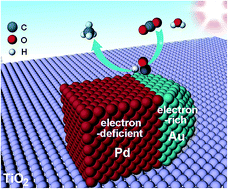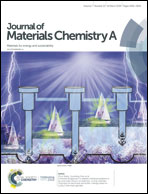Interface engineering on Janus Pd–Au heterojunction co-catalysts for selective photocatalytic reduction of CO2 to CH4†
Abstract
Photocatalytic reduction of CO2 to renewable fuels offers opportunities for long-term energy storage and environmental protection. However, the lack of highly active and selective catalysts impedes the application of this reaction. Here, Janus Pd–Au heterojunctions are proposed as advanced co-catalysts for the conversion of CO2 to CH4, which achieve an unprecedented average CH4 production rate of 48.2 μmol gcat−1 h−1 with a high selectivity of 91.4%. The experimental results indicate that the interfaces between Pd and Au play multiple roles in the enhancement of CO2-to-CH4 conversion: (1) Au atoms around the interface provide the sites for the reduction of CO2 to *CO intermediates and then to CH4; (2) *H intermediates are produced on adjacent Pd atoms on the other side of the interface, which further accelerate the rate-limiting process in conversion of *CO to CH4; (3) charge re-distribution through the Pd–Au interface leads to substantial suppression of H2 and CO evolution on electron-deficient Pd and electron-rich Au, respectively. This work provides fresh insights into the rational interface design of high-performance bimetallic co-catalysts for selective CO2 photoreduction.

- This article is part of the themed collection: 2019 Journal of Materials Chemistry A HOT Papers


 Please wait while we load your content...
Please wait while we load your content...